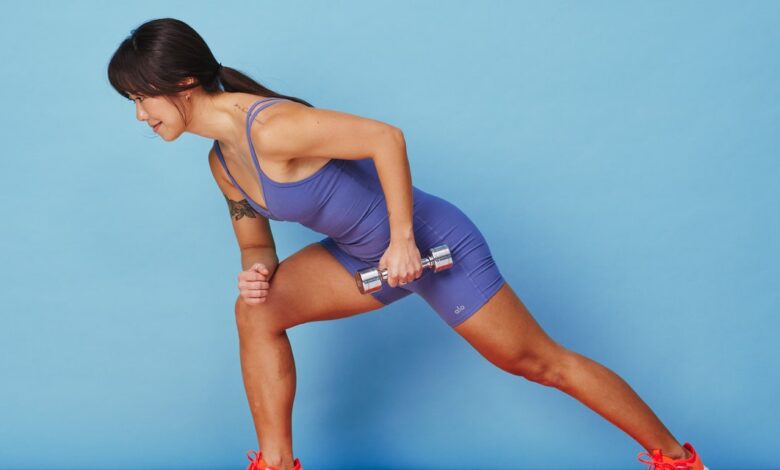This Upper-Body Move Hits Your Back, Biceps, and Core

When building a workout routine, you really can’t go wrong with functional exercises, or ones that mirror actions you do in daily life. One prime example? The single-arm dumbbell row, an upper-body smoker that also sneakily hits your core—while providing a bunch of other benefits too.
Here, we dig into all the one-arm row has to offer, as well as expert tips for incorporating it into your fitness routine. Keep on reading for everything you need to know about your new favorite back-of-the-body exercise.
What muscles do single-arm dumbbell rows work?
The single-arm dumbbell row targets a bunch of upper-body muscles, Teddy Savage, CPT, national lead trainer for Planet Fitness in Baltimore, tells SELF. These include your latissimus dorsi (lats, the broadest of your back muscles), rear deltoids (a shoulder muscle), rhomboids (upper back muscles), and biceps (upper arm muscles). It also hits your trapezius (upper back and neck muscles).
There are a few different ways you can perform the move, but one of the most common variations involves getting into a staggered stance, hinging forward at your hips, and resting one hand on your quad. Thanks to this bent-over positioning—and the unilateral aspect in which just one side of your body is doing most of the work—you’ll also work your core muscles too.
What are the benefits of the single-arm row?
There’s a lot to love about this classic upper-body exercise. Do it regularly, and you can build strength in all of the muscle groups above. Plus, compared to a double-arm row or barbell row, the unilateral version “promotes a greater focus on muscle activation and form,” says Savage. That’s because when you’re working both sides of your body at the same time, “your dominant or stronger side tends to create momentum for your weaker side,” Savage explains. This can lead to muscle imbalances or overcompensation.
But when doing unilateral moves, like the single-arm row, you can place all your focus on activating the muscles needed to complete the exercise correctly, thus upping your chances of good form (and building more balanced whole-body strength).
The unilateral aspect also makes this move a sneaky abs smoker: Your body wants to naturally rotate toward the side that’s holding the weight, but you have to really call on some core stability to prevent that. What’s more, the stance automatically tests your balance, which fires up your core stabilizers to prevent you from tilting to one side. And the bent-over posture, essentially a hip hinge, activates your core muscles in your lower back so they can help steady your spine and keep it in a flat position, explains Savage.
Another benefit: The single-arm row can contribute to better posture, since it strengthens important back muscles that help you sit or stand up straight, Savage says. Finally, because the motion is so similar to common life activities, like pulling a heavy door shut or tugging the starter cord on a lawnmower, it has strong carryover to a bunch of everyday pulling motions—making it a great functional exercise, he says.
What are some common mistakes people make?
Allowing your body to rotate when you pull can take the focus off the muscles you want to target and instead engage others that shouldn’t be the main movement drivers—say, like your lower back. To avoid this, when pulling the dumbbell back, really brace your core to prevent any twisting through your torso, says Savage.
You’ll also want to make sure your elbows don’t flare out too wide, as that can place undue stress on your shoulders. Think about keeping “your elbows as close to your body as possible and feel the fabric of your shirt with each pull,” says Savage.
Next, make sure your shoulders aren’t slouching forward and that your back doesn’t round, since that can also stress on your lower back, which compromises your posture and may ultimately lead to strain. Think about squeezing your shoulder blades together—imagine you’re holding a pencil in place between them—and maintaining a flat back as you perform reps, says Savage.
Then, pick a spot on the floor slightly in front of your lead foot, and keep your gaze locked in there for the duration of your set, he says. This will stop you from craning your head and looking up, which can mess with your ability to keep your back straight and strain your neck.
Lastly, make sure that you are controlling the weight, says Savage. Avoid picking a dumbbell that’s too heavy, which can mess up your form, and instead opt for one that you can “pull and resist with proper control and without relying on momentum,” Savage explains.
How can you incorporate the row into your workout routine?
The single-arm row fits well into a dedicated back workout, since it hits a bunch of those muscles. You can also use it in an upper-body push-pull session, slotting it in alongside other pulling movements, like pulldowns, pull-ups, and bicep curls. Another option: Perform it as part of a full-body strength routine that includes moves like the bench press, deadlift, and squats to hit a bunch of different muscle groups across your body.
Aim for three sets of 10 to 12 reps, says Savage. Use a moderate weight that places noticeable tension on your muscles, “but still allows you to confidently control your pace and range of motion throughout the movement,” he explains. Once you get comfortable with the movement and can do it with good form, you can gradually progress to heavier weights.
New to strength training and not quite feeling comfortable with free weights yet? If you have access to a gym, you can get the motion down first by trying the seated row machine; this beginner-friendly option allows you to sit upright without having to worry about keeping your balance or twisting to the side. “The machine will help guide the path of resistance to keep your elbows in line and the right muscles engaged,” explains Savage. Another option is to perform the move with a resistance band instead of dumbbells, which can allow for a “more steady pull without the worry of choosing a weight that’s too heavy and compromising your form,” says Savage.
More experienced exercisers can progress the move by slowing down the tempo during the eccentric part of the move, when the weight is lowering back down. This will increase the amount of time that your muscles are under tension.
How to do a single-arm row:
Katie Thompson
- Stand with your feet hip-width apart, holding a weight in your left hand with your arm at your side. Step forward about two feet with your right foot, and rest your right hand on your right quad. (You can also place your right arm on a flat bench; this gives you more stability.) This is the starting position.
- With your core engaged, hinge forward at the hips, pushing your glutes back, and bend your right knee, making sure you don’t round your shoulders. (Your hip mobility and hamstring flexibility will dictate how far you can bend over.)
- Gaze at the ground a few inches in front of your feet to keep your neck in a comfortable position.
- Pull the weight up toward your chest, keeping your elbows hugged close to your body, and squeezing your shoulder blade at the top of the movement. Your elbow should go past your back as you bring the weight toward your chest.
- Slowly lower the weight by extending your arms toward the floor. This is 1 rep.
Demoing the move above is Jamie Song, NASM-certified personal trainer based in New York City.
Related:



